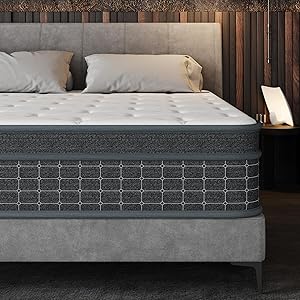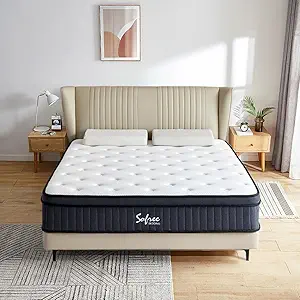How Often Should You Replace Your Mattress?
A good night’s sleep is essential for maintaining overall health, well-being, and productivity. However, the quality of your sleep can be heavily influenced by the mattress you sleep on. Over time, even the most durable mattresses can begin to lose their comfort and support. But how do you know when it’s time to replace your mattress?
The average lifespan of a mattress is around 7 to 10 years, but several factors can influence when you should replace it. We will explore how often you should replace your mattress, the signs to look out for, and tips for choosing a new mattress to ensure you get the best possible sleep.
The Lifespan of a Mattress
The lifespan of a mattress depends on several factors, including its construction, the materials used, how frequently it’s used, and how well it’s cared for. On average, most mattresses should be replaced every 7 to 10 years, but this can vary:
- Innerspring Mattresses: Typically last about 7 to 8 years.
- Memory Foam Mattresses: Can last between 8 to 10 years.
- Latex Mattresses: Often last the longest, up to 10 to 12 years.
- Hybrid Mattresses: Usually last around 8 to 10 years, depending on the quality of the materials.
Keep in mind that the lifespan can be influenced by usage. A mattress that’s used every night by a single person may last longer than one shared by two people, especially if it’s a soft or low-quality mattress.
Signs It’s Time to Replace Your Mattress
If you’re unsure whether it’s time to replace your mattress, several warning signs indicate that it’s no longer providing the support and comfort you need. Here are some common signs to look out for:
1. You Wake Up with Aches and Pains
One of the most obvious signs that your mattress needs replacing is if you consistently wake up with aches and pains. If your mattress has lost its ability to support your spine properly, you may feel stiffness, soreness, or discomfort when you wake up, particularly in your back, neck, or shoulders.
Even if you sleep for 8 hours, a mattress that doesn’t provide proper support can cause misalignment, leading to chronic pain or discomfort. If this happens regularly and your aches don’t resolve after a few minutes of getting out of bed, it’s time to consider a new mattress.
Looking for the perfect fit? Check out these Best-Selling Mattress.






2. The Mattress is Sagging or Lumpy
Sagging is one of the most common signs that your mattress is nearing the end of its lifespan. Over time, the materials inside your mattress (whether memory foam, innerspring coils, or latex) break down, leading to visible sagging or lumps.
If you notice visible indentations where you sleep, or if the middle of the mattress sags, this is a sign that the materials have lost their integrity and are no longer providing adequate support. Sagging can lead to spinal misalignment and worsen your sleep quality, making it essential to replace your mattress.
3. Your Mattress is Over 7 Years Old
Even if your mattress still seems relatively comfortable, it’s important to consider its age. Most mattresses, even high-quality ones, begin to degrade after about 7 to 10 years. Over time, the materials lose their ability to support your body, and the mattress can become uncomfortable.
A mattress older than 7 years may not have the same level of cushioning or support that it did when you first purchased it, which can lead to discomfort and sleep disturbances. If your mattress is approaching this age and you notice any other signs of wear, it’s time to start thinking about a replacement.
4. You’re Not Sleeping as Well
If you find yourself tossing and turning throughout the night or waking up frequently, your mattress could be the culprit. A mattress that’s lost its comfort and support can cause restless sleep, making it difficult to get a full night of rest. Even if you don’t wake up with aches and pains, if you’re not feeling refreshed in the morning, it could be time for a new mattress.
If you find that you’re constantly adjusting your position during the night to find comfort, or you’re waking up more tired than when you went to bed, these are signs that your mattress isn’t offering the support you need for quality sleep.
5. Allergies and Dust Mites
Over time, mattresses can accumulate dust mites, bacteria, allergens, and mold, especially if they’re not regularly cleaned or maintained. If you notice an increase in allergies, asthma, or sneezing, it might be due to your mattress. Dust mites and allergens can be trapped in the fibers and padding of an old mattress, causing health issues.
If your mattress is several years old and you haven’t cleaned or replaced it, it may be time to consider a new one to reduce exposure to allergens. Keep in mind that even with proper maintenance, mattresses can still harbor allergens and bacteria, and a fresh mattress can provide a healthier sleep environment.
6. Visible Wear and Tear
If your mattress has visible signs of wear and tear, such as tears, holes, or broken springs, it’s time to replace it. These physical signs indicate that the structure of the mattress has broken down and will no longer provide the support your body needs. Worn-out mattresses can also affect the overall comfort, leading to a less restful night’s sleep.
If your mattress has a damaged cover, exposed coils, or foam that’s crumbling, it’s no longer safe or effective to use. Even if there aren’t physical tears, if the mattress no longer looks like it did when you first purchased it, this is a sign of aging.
7. It No Longer Meets Your Needs
Your mattress should meet your sleep preferences and body needs. If you’ve gained or lost weight, or if your sleep position has changed over time, your current mattress may no longer be the best fit. For instance, if you used to sleep on your back and now prefer sleeping on your side, you may need a mattress that provides more cushioning for your shoulders and hips.
As your needs evolve, your mattress may need to evolve as well. A mattress that once seemed ideal might no longer be a good match for your body type or sleeping position.
How to Extend the Life of Your Mattress
While mattresses don’t last forever, there are steps you can take to extend their lifespan and keep them in good condition for longer:
- Rotate the Mattress Regularly: Rotating your mattress 180 degrees every 3 to 6 months can help distribute the wear more evenly and prevent sagging. Some mattresses also need to be flipped, so check the manufacturer’s instructions.
- Use a Mattress Protector: A mattress protector can help guard against spills, dirt, and allergens, keeping your mattress cleaner and more hygienic. It can also reduce the wear and tear on the surface of the mattress.
- Clean Your Mattress: Regularly vacuuming your mattress and using an upholstery cleaner can help remove dust, dirt, and allergens. Consider spot-cleaning any stains immediately to prevent long-term damage.
- Ensure Proper Support: Ensure that your mattress is placed on a sturdy bed frame or foundation that provides adequate support. Using a poor-quality bed frame can cause uneven wear on the mattress and shorten its lifespan.
- Avoid Jumping on the Bed: Excessive movement or jumping can damage the internal structure of the mattress, leading to quicker wear and sagging.
When to Consider Replacing Your Mattress
- If You Have Persistent Back or Neck Pain: If you’re waking up with aches and pains, it could be due to inadequate support. Your mattress may need replacing, especially if it’s over 7 years old.
- If Your Mattress is Sagging or Lumpy: Any visible sagging or lumps in the mattress indicate that it’s lost its structural integrity and no longer provides support.
- If You’re Not Sleeping Well: Restlessness, frequent waking, or lack of refreshing sleep could signal that your mattress is no longer serving your needs.
Conclusion
While there’s no one-size-fits-all answer to when you should replace your mattress, paying attention to signs like sagging, discomfort, and poor sleep quality can help you decide when it’s time for a new mattress. On average, most mattresses need to be replaced every 7 to 10 years, but this can vary depending on the type, quality, and care of your mattress.
Replacing your mattress when it no longer supports your body properly can help you sleep better, reduce pain, and improve your overall health. If your mattress is showing signs of wear, or if your sleep quality has declined, don’t hesitate to start shopping for a new one to ensure you’re getting the best rest possible.





